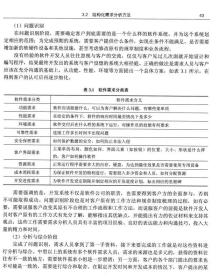
软件工程
全新正版 极速发货
¥ 51.63 6.5折 ¥ 79 全新
库存2件
广东广州
认证卖家担保交易快速发货售后保障
作者(美)罗杰S.普莱斯曼(Roger S.Pressman),(美)布鲁斯R.马克西姆(Bruce R.Maxim) 著
出版社机械工业出版社
ISBN9787111499312
出版时间2016-01
装帧平装
开本16开
定价79元
货号1201233454
上书时间2024-11-15
- 最新上架
商品详情
- 品相描述:全新
- 商品描述
-
作者简介
罗杰S.普莱斯曼(Roger S.Pressman),软件过程改进和软件工程技术方面的靠前知名人士。Pressman博士著有6部著作,并撰写了很多技术文章,是多种行业期刊的固定撰稿人,曾任多种行业杂志的编委,多年来一直担任《IEEE Software》杂志的Manager专栏的编辑。他还是美国计算机协会(ACM)、美国电气与电子工程师协会(IEEE)等组织的成员。
布鲁斯R.马克西姆(Bruce R.Maxim),在30多年的职业生涯中,Maxim博士曾先后担任过软件工程师、项目经理、大学教授、图书作者和技术顾问,具有丰富的产业和学术经验。Maxim博士现为密歇根大学迪尔伯恩分校计算机和信息科学副教授,还是美国计算机协会(ACM)、美国电气与电子工程师协会(IEEE)、美国工程教育学会(ASEE)等组织的成员。
目录
CHAPTER 1 THE NATURE OF SOFTWARE 1
1.1 The Nature of Software 3
1.1.1 De ning Software 4
1.1.2 Software Application Domains 6
1.1.3 Legacy Software 7
1.2 The Changing Nature of Software 9
1.2.1 WebApps 9
1.2.2 Mobile Applications 9
1.2.3 Cloud Computing 10
1.2.4 Product Line Software 11
PROBLEMS AND POINTS TO PONDER 12
FURTHER READINGS AND INFORMATION SOURCES 12
CHAPTER 2 SOFTWARE ENGINEERING 14
2.1 De ning the Discipline 15
2.2 The Software Process 16
2.2.1 The Process Framework 17
2.2.2 Umbrella Activities 18
2.2.3 Process Adaptation 18
2.3 Software Engineering Practice 19
2.3.1 The Essence of Practice 19
2.3.2 General Principles 21
2.4 Software Development Myths 23
2.5 How It All Starts 26
PROBLEMS AND POINTS TO PONDER 27
FURTHER READINGS AND INFORMATION SOURCES 27
PART ONE THE SOFTWARE PROCESS 29
CHAPTER 3 SOFTWARE PROCESS STRUCTURE 30
3.1 A Generic Process Model 31
3.2 De ning a Framework Activity 32
3.3 Identifying a Task Set 34
3.4 Process Patterns 35
PROBLEMS AND POINTS TO PONDER 37
FURTHER READINGS AND INFORMATION SOURCES 38
CHAPTER 4 PROCESS MODELS 39
4.1 Prescriptive Process Models 40
4.1.1 The Waterfall Model 40
4.1.2 Incremental Process Models 42
4.1.3 Evolutionary Process Models 44
4.1.4 Concurrent Models 48
4.1.5 A Final Word on Evolutionary Processes 50
4.2 Specialized Process Models 51
4.2.1 Component-Based Development 52
4.2.2 The Formal Methods Model 52
4.2.3 Aspect-Oriented Software Development 53
4.3 The Uni ed Process 54
4.3.1 A Brief History 55
4.3.2 Phases of the Uni ed Process 55
4.4 Product and Process 57
PROBLEMS AND POINTS TO PONDER 59
FURTHER READINGS AND INFORMATION SOURCES 59
CHAPTER 5 AGILE DEVELOPMENT 60
5.1 What Is Agility? 62
5.2 Agility and the Cost of Change 62
5.3 What Is an Agile Process 63?
5.3.1 Agility Principles 64
5.3.2 The Politics of Agile Development 65
5.4 Extreme Programming 66
5.4.1 The XP Process 66
5.4.2 Industrial XP 69
5.5 Other Agile Process Models 71
5.5.1 Scrum 72
5.5.2 Dynamic Systems Development Method 73
5.5.3 Agile Modeling 74
5.5.4 Agile Uni ed Process 76
5.6 A Tool Set for the Agile Process 77
PROBLEMS AND POINTS TO PONDER 78
FURTHER READINGS AND INFORMATION SOURCES 79
CHAPTER 6 HUMAN ASPECTS OF SOFTWARE ENGINEERING 81
6.1 Characteristics of a Software Engineer 82
6.2 The Psychology of Software Engineering 83
6.3 The Software Team 84
6.4 Team Structures 86
6.5 Agile Teams 87
6.5.1 The Generic Agile Team 87
6.5.2 The XP Team 88
6.6 The Impact of Social Media 89
6.7 Software Engineering Using the Cloud 91
6.8 Collaboration Tools 92
6.9 Global Teams 93
PROBLEMS AND POINTS TO PONDER 94
FURTHER READINGS AND INFORMATION SOURCES 95
PART TWO MODELING 97
CHAPTER 7 UNDERSTANDING REQUIREMENTS 98
7.1 Requirements Engineering 99
7.2 Establishing the Groundwork 105
7.2.1 Identifying Stakeholders 106
7.2.2 Recognizing Multiple Viewpoints 106
7.2.3 Working toward Collaboration 107
7.2.4 Asking the First Questions 107
7.3 Eliciting Requirements 108
7.3.1 Collaborative Requirements Gathering 109
7.3.2 Quality Function Deployment 112
7.3.3 Usage Scenarios 112
7.3.4 Elicitation Work Products 113
7.3.5 Agile Requirements Elicitation 114
7.3.6 Service-Oriented Methods 114
7.4 Developing Use Cases 115
7.5 Building the Analysis Model 120
7.5.1 Elements of the Analysis Model 120
7.5.2 Analysis Patterns 123
7.5.3 Agile Requirements Engineering 124
7.5.4 Requirements for Self-Adaptive Systems 124
7.6 Avoiding Common Mistakes 125
PROBLEMS AND POINTS TO PONDER 125
FURTHER READINGS AND OTHER INFORMATION SOURCES 126
CHAPTER 8 REQUIREMENTS MODELING: SCENARIO-BASED METHODS 128
8.1 Requirements Analysis 129
8.1.1 Overall Objectives and Philosophy 130
8.1.2 Analysis Rules of Thumb 131
8.1.3 Domain Analysis 132
8.1.4 Requirements Modeling Approaches 133
8.2 Scenario-Based Modeling 135
8.2.1 Creating a Preliminary Use Case 135
8.2.2 Re ning a Preliminary Use Case 138
8.2.3 Writing a Formal Use Case 139
8.3 UML Models That Supplement the Use Case 141
8.3.1 Developing an Activity Diagram 142
8.3.2 Swimlane Diagrams 143
PROBLEMS AND POINTS TO PONDER 144
FURTHER READINGS AND INFORMATION SOURCES 145
CHAPTER 9 REQUIREMENTS MODELING: CLASS-BASED METHODS 146
9.1 Identifying Analysis Classes 147
9.2 Specifying Attributes 150
9.3 De ning Operations 151
9.4 Class-Responsibility-Collaborator Modeling 154
9.5 Associations and Dependencies 160
9.6 Analysis Packages 161
PROBLEMS AND POINTS TO PONDER 162
FURTHER READINGS AND INFORMATION SOURCES 163
CHAPTER 10 REQUIREMENTS MODELING: BEHAVIOR, PATTERNS, AND燱EB/MOBILE APPS 164
10.1 Creating a Behavioral Model 165
10.2 Identifying Events with the Use Case 165
10.3 State Representations 166
10.4 Patterns for Requirements Modeling 169
10.4.1 Discovering Analysis Patterns 170
10.4.2 A Requirements Pattern Example: Actuator-Sensor 171
PROBLEMS AND POINTS TO PONDER 175
FURTHER READINGS AND INFORMATION SOURCES 176
CHAPTER 11 DESIGN CONCEPTS 177
11.1 Design within the Context of Software Engineering 178
11.2 The Design Process 1811
1.2.1 Software Quality Guidelin
相关推荐
— 没有更多了 —





















以下为对购买帮助不大的评价